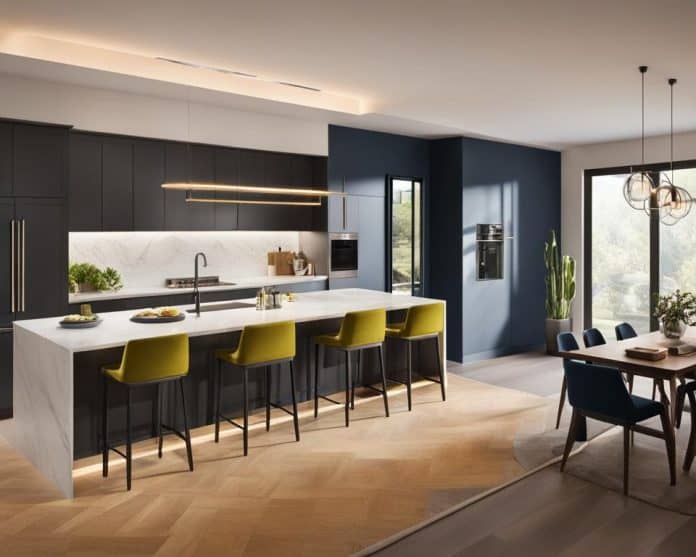
Embarking on a kitchen renovation can be both exhilarating and overwhelming. As the heart of your home, the kitchen isn’t just a place to prepare meals but a hub for family gatherings, entertainment, and daily activities. A well-planned kitchen makeover can significantly enhance your living space’s functionality and aesthetic appeal, not to mention potentially boosting your home’s overall value. This kitchen renovation guide is designed to unfold the vast potential residing in your current kitchen layout, offering transformative kitchen design ideas that cater to both your personal style and practical needs.
Whether you’re leaning towards a minor kitchen refresh or a complete home improvement overhaul, the essence of a successful kitchen remodel lies in meticulous planning and design selection. In the following sections, we’ll delve into each stage of a kitchen makeover journey, from the basics of planning to the finishing touches on your dream kitchen. Spurred by insights from the National Association of the Remodeling Industry on renovation values and favored by statistics from Houzz’s Kitchen Trends Study on popular design features, you’re set to shape a kitchen that’s both en vogue and timelessly elegant.
Key Takeaways
- Comprehend the personal and financial benefits of a kitchen remodel.
- Strategic planning is the cornerstone of a successful kitchen renovation.
- Understand the importance of choosing the right design that fits your lifestyle and home’s architecture.
- Learn from industry experts on the value and trends in kitchen renovations.
- Stay tuned for a comprehensive journey from concept to execution of your kitchen makeover.
Understanding the Basics of Kitchen Remodel Planning
Embarking on a kitchen remodel is an exciting journey that blends creativity with strategic planning. As you envision the transformation of your kitchen, it’s essential to map out each step to ensure a smooth renovation process. Initiate your project by evaluating the existing space, establishing a budget with cushioning for the unexpected, and crafting a timeline that aligns with your daily life and any significant milestones.
Evaluating Your Current Kitchen Layout
To optimize your kitchen’s functionality and aesthetic, a thorough evaluation of your current layout is critical. Reflect on aspects such as space utilization, storage capabilities, and movement flow within the area. Identify which features serve you well and which ones are due for a revamp. This will form the foundation of your kitchen design planning process.
Setting a Realistic Budget
Creating a budget for your kitchen renovation is more than just tallying up numbers; it’s about setting expectations and making informed decisions. It’s a balancing act between your dream features and the practicality of your remodeling budget. Be sure to include buffer funds for any unforeseen expenses to mitigate stress and avoid compromising on quality.
Timelines and Scheduling Your Remodel
A clear and feasible renovation timeline is a linchpin for the success of your remodel. Be realistic about the length of time each phase might take and account for the availability of contractors. Consider the impact of seasonal factors and holidays, and always prepare for possible delays, ensuring a well-orchestrated kitchen update.
| Project Phase | Duration Estimate | Key Considerations |
|---|---|---|
| Design & Planning | 3-6 Weeks | Selecting layout, materials, hiring designers/contractors |
| Ordering Materials | 4-8 Weeks | Lead times for cabinets, countertops, appliances |
| Construction | 6-12 Weeks | Demolition, electrical, plumbing, installation |
| Finishing Touches | 1-2 Weeks | Backsplash, painting, lighting fixtures |
To enable space optimization, consider every nook and explore innovative storage solutions that contribute to a functional and streamlined kitchen environment. Remember, thorough preparation is the secret ingredient to a successful kitchen makeover, blending practicality with your personal style to create a space that not only looks great but also enhances daily life.
Design Styles and Themes for Your New Kitchen
Embarking on a kitchen remodel presents a prime opportunity to reflect your personal taste through your choice of kitchen decor themes. Balancing aesthetics with functionality creates a space that is not only inviting but also enjoyable to cook and entertain in. The following details will help guide you through selecting the perfect design elements for your kitchen revival.
Traditional vs. Modern Kitchens
The dichotomy between traditional kitchen style and modern kitchen design lies chiefly in their approach to aesthetics and functionality. Traditional kitchens often evoke a sense of warmth with their classic lines and ornate details, while modern kitchens embrace minimalism and sleekness. Let’s explore a few characteristics that distinctly set them apart:
| Traditional Kitchen Style | Modern Kitchen Design |
|---|---|
| Natural materials such as wood and stone | Industrial materials like stainless steel and glass |
| Intricate architectural features like crown molding or coffered ceilings | Clean lines, uncluttered spaces, with flat-panel doors |
| Rich, deep color palettes | Neutral or monochromatic color schemes |
| Decorative lighting fixtures | Streamlined lighting with a focus on functionality |
| Classic hardware finishes such as bronze or brass | Sleek hardware, often integrated or concealed |
Choosing a Color Scheme
When it comes to kitchen color palettes, personal preference should align with timeless appeal. Contemporary trends may be tempting, but classic choices remain enduring. Here are some suggestions to develop a color theme that stands the test of time:
- Neutral tones offer flexibility, serving as a perfect backdrop for any kitchen decor themes.
- Bolder shades can be introduced through accessories or appliances, easily updated as trends evolve.
- The combination of colors should provide contrast and depth, creating an alluring visual texture.
- Consider the natural light in your kitchen – it can dramatically affect the appearance of colors throughout the day.
Cabinetry and Countertop Options
Cabinets are the backbone of kitchen design, both in function and aesthetic. Countertops, similarly, are a central feature that unify the kitchen’s decor. Here’s an overview of cabinet selections and countertop options:
- Wood Cabinets: Time-honored and versatile, they can be painted or stained to suit any traditional kitchen style.
- Laminate Cabinets: A budget-friendly option that offers a variety of modern finishes and colors.
- Stone Countertops: Granite and marble are popular for their durability and natural patterns.
- Engineered Stone: Quartz offers a modern look and is renowned for its low maintenance and vast color options.
- Butcher Block: Wood countertops add warmth and are ideal for traditional designs.
- Stainless Steel: For a sleek, industrial look, stainless steel can create a striking modern kitchen.
In considering these themes and elements, ensure that they not only speak to your personal style but also hold practical value for your everyday kitchen use. Trends may come and go, but the true beauty of a kitchen’s design is its ability to stand the test of time while providing a functional space for culinary exploration.
Maximizing Kitchen Functionality and Flow
When planning a kitchen remodel, it’s imperative to focus on kitchen layout design and efficient kitchen setup to ensure that every slice, dice, and stir is done with ease and pleasure. An ergonomic kitchen planning strategy considers the movements one makes while cooking and aims to minimize them, thereby saving time and reducing fatigue. This is where the work triangle concept, a time-tested principle in kitchen design, comes into play.
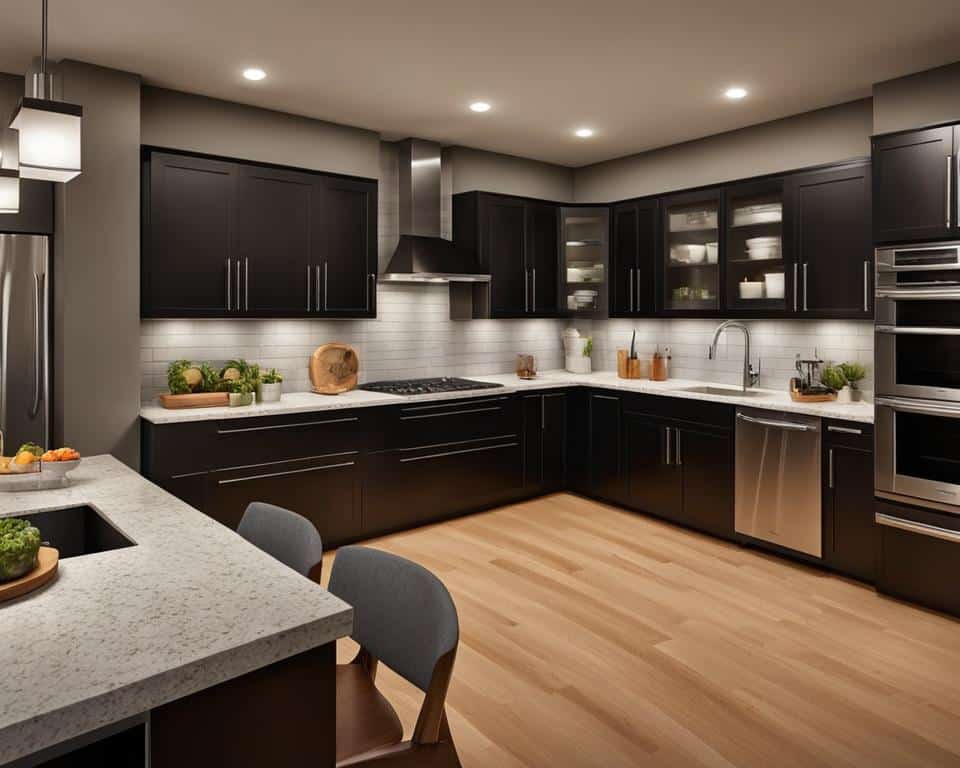
The work triangle is formed by the stove, sink, and refrigerator, which are the three key workstations in any kitchen. Ideally, no leg of the triangle should be less than 4 feet or more than 9 feet, allowing for efficiency and preventing any one work area from becoming a bottleneck during meal prep.
“An optimal kitchen layout follows the work triangle concept, creating a balanced workspace where functionality meets convenience.” – National Kitchen & Bath Association
For small kitchens or those with layout challenges, there are numerous solutions to enhance functionality:
- Implementing vertical storage to maximize space
- Choosing slim appliances that don’t compromise performance
- Integrating multi-purpose islands, if space permits
- Using innovative cabinet solutions like lazy Susans in corner cabinets
| Layout Problem | Solution | Benefit |
|---|---|---|
| Limited counter space | Add a foldable extension or mobile island | Increases prep area without permanent space usage |
| Cluttered pathways | Reorganize layout to open up central floor space | Improves foot traffic and avoids bottlenecks |
| Inaccessible storage | Replace upper cabinets with open shelving | Brings items within easy reach and creates an airy feel |
| Poor workflow | Adjust layout to reflect the work triangle | Enhances efficiency by reducing unnecessary movement |
Remember that the heart of ergonomic kitchen planning isn’t just about physical comfort; it’s also about creating a harmonious space that fosters the joy of cooking and socializing. By keeping these principles in mind, you’re well on your way to crafting a kitchen that’s both beautiful and operational.
Selecting the Right Appliances for Your Kitchen Remodel
When it comes to a kitchen remodel, selecting appliances that align with your sustainability goals and design aesthetics is as crucial as choosing the right cabinetry or countertops. Energy efficiency, seamless design integration, and the prowess of smart technology can not only enhance the kitchen’s functionality but also contribute to considerable energy savings and a reduced environmental footprint.
Energy Efficiency and Sustainability Choices
Investing in sustainable kitchen appliances is a forward-thinking move that pays dividends in both the short and long term. Not only do these energy-saving kitchen devices trim down your utility bills, but they also support your eco-friendly lifestyle. Brands carrying the ENERGY STAR rating are vetted for their efficiency, ensuring that your kitchen remodel reflects a commitment to sustainability.
Integrating Appliances into Your Design
The contemporary kitchen thrives on the harmony between functionality and style. Appliance integration is a design strategy that makes your refrigerators, dishwashers, and ovens complement the cabinetry and aesthetics of your space. Flush installation and panel-ready models are popular solutions for a seamless and custom look that enhances the streamlined feel of any kitchen design.
Smart Kitchen Technologies
In the age of digital innovation, smart home gadgets are redefining the culinary environment. From refrigerators that help you keep track of groceries to ovens that can be controlled remotely, the latest gadgets bring a new level of convenience and control to your kitchen. With features like voice commands and app integration, these devices turn your kitchen into a hub of modern living.
Consider the following table of comparisons as a guide when selecting the perfect blend of efficiency, design, and technology for your remodeled kitchen:
| Appliance Type | Energy Efficiency | Design Integration | Smart Features |
|---|---|---|---|
| Refrigerator | ENERGY STAR Rated | Panel-Ready, Custom Color | Food Inventory Tracking, App Control |
| Oven | Convection Cooking, Self-Cleaning | Flush Installation | Remote Preheat, Temperature Probe |
| Dishwasher | Water & Energy Efficient Cycles | Hidden Controls | Soil Sensor, Cycle Customization |
| Microwave | Inverter Technology | Drawer Style | Voice Controlled, Preset Menus |
Equipped with the insights from ENERGY STAR recommendations and the latest CNET reviews on smart kitchen gadgets, your journey to incorporating sustainable kitchen appliances into your remodel can be both exciting and environmentally responsible. Embrace the blend of technology, style, and sustainability to create a kitchen that’s not only a pleasure to use but also kind to the planet.
Lighting: The Key to Enhancing Your Kitchen’s Ambience
The heart of any home, the kitchen, isn’t just a space for culinary creativity but also a place where ambiance is paramount. Achieving the perfect balance in kitchen lighting design calls for a strategic layering of ambient lighting, task lighting, and accent lighting. Each layer serves a unique purpose, and when combined, they create a warm and welcoming environment that’s both functional and aesthetically pleasing.
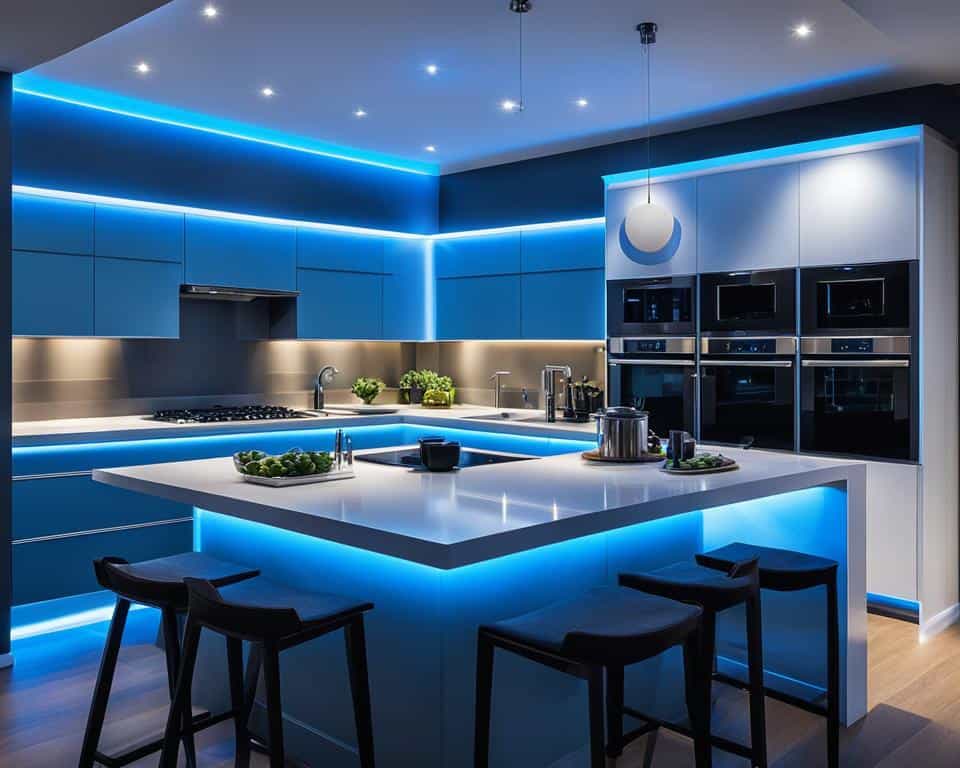
Ambient lighting offers a soft glow that fills the room, creating an inviting atmosphere without overpowering. It sets the stage for the entire space and is often achieved through ceiling-mounted or recessed lighting fixtures that provide a consistent level of light. Task lighting, on the other hand, is about functionality. Positioned to shine on the areas where you chop, sauté, and read recipes, these fixtures ensure no shadow falls on your workspace, providing focused illumination right where you need it.
- Consider the size and shape of your kitchen when selecting ambient lighting fixtures to ensure that the light is evenly distributed.
- Look for task lighting options that can be easily adjusted and positioned to eliminate shadows and glare.
- Use accent lighting to highlight architectural features or display areas, adding depth and dimension to the kitchen’s overall design.
When planning your kitchen’s lighting scheme, consider the color temperature of bulbs as well. Warmer tones create a cozy feel, ideal for ambient lighting, while cooler tones are suitable for task lighting to provide a clear view. As indicated by the American Lighting Association, choosing the right combination of these elements is vital for a successful kitchen lighting design. By incorporating a mix of overhead lights, pendant lights, under-cabinet strips, and possibly even in-cabinet lights, you can ensure that your kitchen is not only practical but also a reflection of your personal style.
- Overhead ambient lighting for a uniform light layer
- Under-cabinet LEDs for task lighting on countertops
- Pendant fixtures for accent lighting over the kitchen island
- Recessed spotlights on dimmers for adaptable ambiance
Remember, the key to good lighting is balance. A delightful combination of various lighting fixtures can enhance visibility, create mood, and transform your kitchen into an irresistible retreat for both cooking and conversing.
Expert Tips for Choosing Durable Flooring and Backsplashes
When it comes to kitchen remodels, selecting the right materials is crucial for both functionality and style. Aesthetic appeal, durability, and maintenance are the pillars of good kitchen floors and backsplashes. With the wealth of options available, this section aims to guide you through some of the most durable materials and easy-clean surfaces, as well as current design trends to enhance your home.
Types of Kitchen Flooring Materials
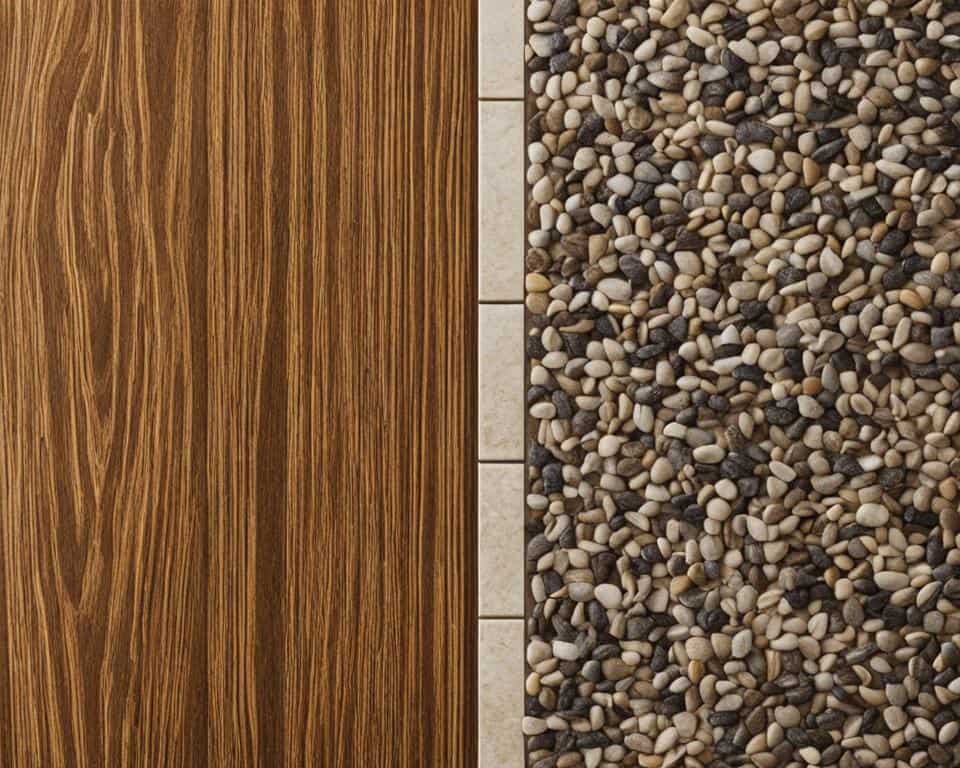
Choosing the perfect flooring material for your kitchen goes beyond picking a color. Here are the top contenders known for their durability and ease of maintenance:
- Hardwood: Renowned for its timeless beauty, it can withstand the demands of a busy kitchen when properly sealed.
- Porcelain Tile: Offers exceptional durability and a variety of design options. It’s a popular choice for kitchen floors, thanks to its resistance to spills and stains.
- Vinyl Flooring: A budget-friendly option that doesn’t skimp on durability. Modern vinyl is waterproof, scratch-resistant, and comes in a range of styles.
- Stone: Natural stone floors such as slate, granite, or marble are prized for their unique patterns and long-lasting durability.
Backsplash Design Patterns and Materials
The backsplash not only serves as protection for your kitchen walls but also as a focal point of aesthetic intrigue. Let’s look at current trends in backsplash design:
- Subway Tiles: A classic choice that’s still going strong, subway tiles can be arranged in a variety of patterns to create different effects.
- Mosaic Tiles: For a splash of personality, mosaic tiles come in various colors and finishes to match any kitchen style.
- Glass Tiles: They offer a modern look and reflect light beautifully, making your kitchen appear larger and brighter.
- Metallic Finishes: If you’re aiming for a contemporary kitchen, consider backsplash tiles with metallic finishes for an edgy touch.
Maintenance and Longevity Considerations
Investing in durable materials for your kitchen floors and backsplash ideas will ensure that your space not only looks great but also stands up to the test of time with minimal upkeep. Here are some easy-clean surfaces and tips to help you maintain them:
- Ceramic and Porcelain: These can typically be cleaned with a damp mop or cloth without the need for harsh chemicals.
- Natural Stone: While incredibly durable, it often requires sealing and should be cleaned with products designed for stone to prevent damage.
- Glass Tiles: Are easy to wipe clean but can show water spots, so regular polishing might be needed to keep them looking their best.
- Luxury Vinyl: One of the most low-maintenance options available. Spills can be wiped away quickly, and the flooring can be swept or vacuumed regularly.
Choosing the right combination of style and substance will ensure that your kitchen is not only beautiful but also a practical space that endures over time. Turn to trusted sources like The Tile Shop and Flooring America to compare different materials and find the best fit for your home renovation.
Organizing Your Space: Storage Solutions for Every Kitchen
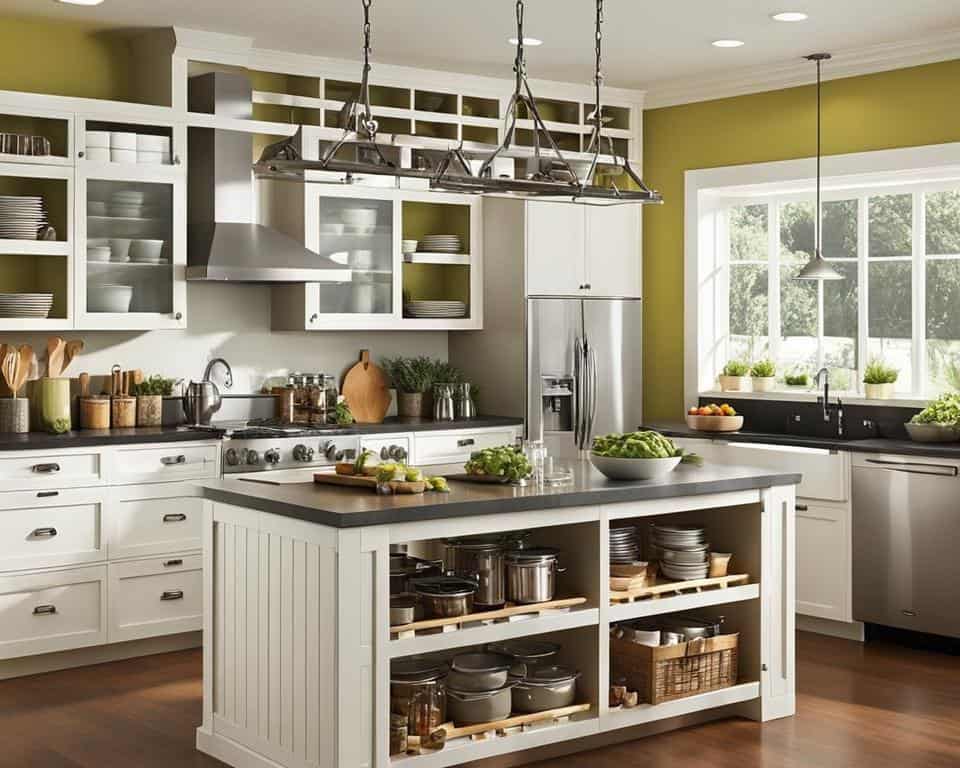
Revamping your kitchen to create a clutter-free sanctuary is not only about aesthetic appeal but also about embracing practicality. A well-organized kitchen simplifies meal preparation, reduces cleanup time, and maximizes space utilization. With kitchen storage ideas that cater to a variety of needs, and clever pantry organization techniques, achieving a clutter-free kitchen is within reach.
Space maximization is the cornerstone of a seamless culinary experience. Innovative storage solutions like pull-out pantries not only provide easy access but also offer a comprehensive overview of your pantry contents at a glance. Corner drawers turn potentially wasted spaces into treasure troves of efficiency, while appliance garages conceal small appliances, maintaining a tidy countertop.
Below, find a table detailing various storage options and their benefits:
| Storage Solution | Benefits | Best For |
|---|---|---|
| Pull-Out Pantries | Full visibility and access, space-efficient, customizable shelving | Bulk food items, cans, jars, bottles |
| Corner Drawers | Utilizes corner spaces, split storage options, ergonomic design | Cooking utensils, pots, and pans |
| Appliance Garages | Hides appliances, reduces counter clutter, custom sizes available | Toasters, blenders, coffee makers |
| Overhead Cabinets | Vertical storage, adjustable shelving, variety of styles and finishes | Glasses, plates, special occasion china |
While finding the right mix of storage units, it’s imperative to organize commonly used items for efficiency. Labeling systems and transparent containers can aid in maintaining order in your kitchen, ensuring that every ingredient and utensil has a designated place and is easy to locate.
As Marie Kondo, the organizational guru, affirms, “The objective of cleaning is not just to clean, but to feel happiness living within that environment.” So, consider the joy obtained from a well-ordered, functional kitchen when implementing these storage solutions.
Considering these elements can turn the hub of your home into a hallmark of harmonious design and practicality. With these kitchen storage ideas, your journey to a clutter-free kitchen will lead you to not just a reimagined space but an entirely enhanced way of living in your kitchen.
Working with Contractors: How to Communicate Your Vision Effectively
Fostering effective communication and establishing clear expectations with kitchen contractors can make or break your remodeling experience. The key to any successful kitchen remodel lies not only in the design details and materials chosen but also in the relationships built with professionals who bring those ideas to life. Let’s delve into the best practices for hiring kitchen contractors, navigating remodeling agreements, and ensuring robust project management.
Researching and Hiring Trusted Professionals
Embarking on the process of hiring kitchen contractors should begin with thorough research. Seek out contractors with a positive reputation and relevant experience. Consult the Better Business Bureau and read reviews to gauge past customer experiences. It’s essential to have contractors who are not only skilled in their craft but also show a willingness to understand your vision and goals for the kitchen remodel.

Navigating Contracts and Agreements
Once you’ve found a contractor that aligns with your project’s needs, securing a well-drafted contract is crucial. A comprehensive contract should cover project scope, cost, timeline, and any other critical expectations. These remodeling agreements serve as a roadmap and a legal safeguard for both homeowner and contractor, detailing what’s to be done, how it will be accomplished, and the benchmarks for progress and completion.
Project Management and Oversight Practices
Effective project management is paramount in bringing your kitchen remodel to fruition. As a homeowner, staying proactive in managing the project includes regular check-ins with the contractor, overseeing timelines, and being available for crucial decision-making moments. This oversight ensures that your project stays on track and that any issues are swiftly addressed, ultimately leading to a successful remodel that meets your expectations.
By following these strategic steps—meticulous contractor selection, thorough remodeling agreements, and proactive project management—you’ll be poised for a kitchen remodel marked by smooth execution and collaboration. Enjoy the journey towards creating your dream kitchen, knowing that open and effective communication with your trusted professionals is the cornerstone of this transformative process.
The Do’s and Dont’s of DIY in a Kitchen Remodel
Embarking on a DIY kitchen renovation can be a fulfilling endeavor, offering a personal touch to your home while potentially saving on costs. However, before swinging that hammer, it’s vital to evaluate your skills realistically and understand the intricacies involved. Home improvement safety should never be compromised, and professional remodeling assistance might be needed for tasks exceeding your DIY prowess. This section will inform you of the essentials to consider when diving into a DIY kitchen remodel project.
Assessing Your DIY Skill Level
Begin by thoroughly assessing your DIY skill level. Simple tasks like painting walls or changing hardware might be well within your wheelhouse, but more complex jobs such as plumbing or electrical work may necessitate a different set of skills. Don’t overestimate your capabilities; match your tasks to your actual skill set. DIY kitchen tips often recommend starting with smaller projects and gradually moving to more challenging tasks as you gain confidence and experience.
Safety Precautions and Best Practices
Adhering to safety precautions and best practices is non-negotiable. Home renovation, particularly in high-stakes areas like kitchens, can involve risks. Consult with the guidelines set forth by the Occupational Safety and Health Administration (OSHA) to understand necessary safety procedures. Wear appropriate gear, work in a well-ventilated area, and ensure all tools are in good condition. Remember, cutting corners on safety can lead to severe consequences.
When to Call in the Professionals
Understanding when to call in the professionals can save you time, money, and potential heartache in the long run. Tasks that affect the structural integrity of your home, require permits, or could result in costly damage if mishandled are usually best left to experts. Professional remodeling assistance comes with the assurance that complex elements of your kitchen remodel are executed safely and to code. When in doubt, consult a professional to evaluate the scope of work and avoid the pitfalls of overextending your DIY abilities.
FAQ
What are some important aspects to consider when planning a kitchen remodel?
Strategic planning, design selection, budgeting, and practical considerations such as function, storage, and aesthetics are crucial for a successful kitchen remodel. Additionally, understanding the potential boost in home value and the enhanced enjoyment of a renewed space are important aspects to consider.
How can I evaluate my current kitchen layout effectively?
Start by assessing your kitchen’s strengths and weaknesses, considering factors such as functionality, storage capacity, and aesthetics. Then, utilize insights from the National Association of the Remodeling Industry and statistics from Houzz’s Kitchen Trends Study to inform your planning process.
What should I keep in mind when setting a budget for my kitchen renovation?
Creating a feasible budget should include expected costs for materials, labor, and a contingency for unforeseen expenses. Consumer Reports offers detailed budget considerations, and Remodeling Magazine can provide advice on managing your renovation finances.
How do I choose the right design style for my new kitchen?
Consider your personal tastes and the overall style of your home. Compare traditional and modern aesthetics, and look to sources like Architectural Digest for inspiration, and Better Homes & Gardens for guidance on color schemes and materials for kitchen elements.
What is the “work triangle” and how does it affect kitchen layout design?
The work triangle concept involves placing the stove, refrigerator, and sink at points of a triangle for efficient movement in the kitchen. It is a fundamental aspect in creating an ergonomic and efficient kitchen setup, as outlined by the National Kitchen & Bath Association.
How should I approach the selection of appliances for my kitchen remodel?
Focus on energy efficiency and sustainability for savings and environmental benefits. Integration into your design is key for a cohesive look, and considering smart kitchen technologies can enhance convenience. ENERGY STAR ratings and CNET reviews can guide you in making the right choices.
Can you explain the importance of lighting in a kitchen remodel?
A well-planned lighting scheme combines ambient, task, and accent lighting to enhance the kitchen’s ambiance. It provides visibility, highlights design elements, and creates a welcoming atmosphere. The American Lighting Association offers valuable insights into kitchen lighting planning.
What are some durable materials for flooring and backsplashes in a kitchen?
When choosing materials for floors and backsplashes, consider durability, aesthetic appeal, and maintenance requirements. Research the latest trends and materials through sources like The Tile Shop, and weigh the long-term care and endurance with help from Flooring America’s comparisons.
How can I ensure my kitchen has ample storage space?
Optimize your space with innovative storage solutions such as pull-out pantries, corner drawers, and appliance garages. Marie Kondo’s decluttering strategies and tips for organizing commonly used items can help maintain a clutter-free and efficient kitchen.
What should I know about working with contractors for my kitchen remodel?
It’s essential to choose contractors with a proven track record, understand the contracts and agreements, and manage the project effectively. The Better Business Bureau offers tips on selecting and communicating with home improvement contractors to ensure your vision is realized.
When is it appropriate to DIY during a kitchen renovation?
Assess your DIY skills carefully and match the tasks you undertake accordingly. Always prioritize safety and consider OSHA’s guidelines. For complex tasks or if you’re unsure, it’s beneficial to call in professionals to prevent costly mistakes. The DIY Network provides excellent guidelines for kitchen DIY projects.











































